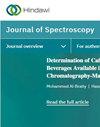Measurement of Phenolic Compounds by Spectrometry and Chromatography in Lime Juices
IF 2.1
4区 化学
Q4 BIOCHEMICAL RESEARCH METHODS
引用次数: 2
Abstract
Juice demand has been increasing at a rapid rate in recent years, and one of the major efforts underway to meet this demand is to minimize changes during the juice process. Due to the high consumption of juice and the carcinogenicity of synthetic and chemical substances, this research uses high performance liquid chromatography (HPLC) and spectrophotometry to detect fake juices. For the detection of fraud, the tests of sodium and potassium content along with determining the amount of flavonoids (hesperidin and eriocitrin) were carried out using spectrophotometry and HPLC. The results showed the average amount of total polyphenol was from 32.4 to 42.6 mg L-1. The total polyphenol content in all samples conformed to the standard, and there was no significant difference between the samples and the standard. The amounts of flavonoids (hesperidin and eriocitrin) in the juice samples were below the standard level (a minimum of 90 and 20 g/mL, respectively). Also, there was a significant difference between the mean sodium and potassium content of standard versus feigned juices. Generally, the amount of hesperidin, eriocitrin, Na+, and K+ as diagnostic biomarkers of natural juice in all samples was below the standard level. All the analysed samples in the experiment were nonstandard. There is a lot of fraud in the juice business, so it has been suggested that the government should have more control over how manufacturing companies make juice.酸橙汁中酚类化合物的光谱色谱测定
近年来,果汁需求一直在快速增长,为了满足这一需求,正在进行的主要努力之一是尽量减少果汁加工过程中的变化。由于果汁的高消费量和合成化学物质的致癌性,本研究采用高效液相色谱法(HPLC)和分光光度法检测假冒果汁。为防伪,采用分光光度法和高效液相色谱法测定其钠、钾含量和黄酮类化合物(橙皮苷和苦皮苷)的含量。结果表明,总多酚的平均含量为32.4 ~ 42.6 mg L-1。所有样品的总多酚含量均符合标准,样品与标准之间无显著差异。果汁样品中黄酮类化合物(橙皮苷和苦皮苷)的含量低于标准水平(最低分别为90和20 g/mL)。此外,标准果汁和假果汁的钠和钾的平均含量也有显著差异。天然果汁的诊断性生物标志物橙皮苷、橙皮苷、Na+、K+含量普遍低于标准水平。实验中所分析的样品均为非标准样品。果汁行业存在很多欺诈行为,因此有人建议政府应该对制造公司如何生产果汁有更多的控制。
本文章由计算机程序翻译,如有差异,请以英文原文为准。
求助全文
约1分钟内获得全文
求助全文
来源期刊

Journal of Spectroscopy
BIOCHEMICAL RESEARCH METHODS-SPECTROSCOPY
CiteScore
3.00
自引率
0.00%
发文量
37
审稿时长
15 weeks
期刊介绍:
Journal of Spectroscopy (formerly titled Spectroscopy: An International Journal) is a peer-reviewed, open access journal that publishes original research articles as well as review articles in all areas of spectroscopy.
 求助内容:
求助内容: 应助结果提醒方式:
应助结果提醒方式:


